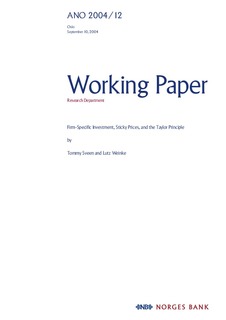| dc.contributor.author | Sveen, Tommy | |
| dc.contributor.author | Weinke, Lutz | |
| dc.date.accessioned | 2018-05-18T10:05:25Z | |
| dc.date.available | 2018-05-18T10:05:25Z | |
| dc.date.issued | 2004 | |
| dc.identifier.isbn | 82-7553-256-6 | |
| dc.identifier.isbn | 82-7553-257-4 | |
| dc.identifier.issn | 0801-2504 | |
| dc.identifier.issn | 1502-8143 | |
| dc.identifier.uri | http://hdl.handle.net/11250/2498533 | |
| dc.description.abstract | According to the Taylor principle a central bank should adjust the nominal interest rate by more than one for one in response to changes in current inflation. Most of the existing literature supports the view that by following this simple recommendation a central bank can avoid being a source of unnecessary fluctuations in economic activity. The present paper shows that this conclusion is not robust with respect to the modelling of capital accumulation. We use our insights to discuss the desirability of alternative arrangements for the conduct of monetary policy. | nb_NO |
| dc.language.iso | eng | nb_NO |
| dc.publisher | Norges Bank | nb_NO |
| dc.relation.ispartofseries | Working Papers;12/2004 | |
| dc.rights | Attribution-NonCommercial-NoDerivatives 4.0 Internasjonal | * |
| dc.rights.uri | http://creativecommons.org/licenses/by-nc-nd/4.0/deed.no | * |
| dc.subject | JEL: E22 | nb_NO |
| dc.subject | JEL: E31 | nb_NO |
| dc.subject | sticky prices | nb_NO |
| dc.subject | investment | nb_NO |
| dc.subject | monetary policy | nb_NO |
| dc.title | Firm-Specific Investment, Sticky Prices, and the Taylor Principle | nb_NO |
| dc.type | Working paper | nb_NO |
| dc.description.version | publishedVersion | nb_NO |
| dc.subject.nsi | VDP::Samfunnsvitenskap: 200::Økonomi: 210::Samfunnsøkonomi: 212 | nb_NO |
| dc.source.pagenumber | 23 | nb_NO |

